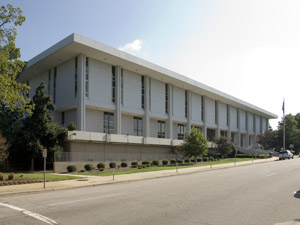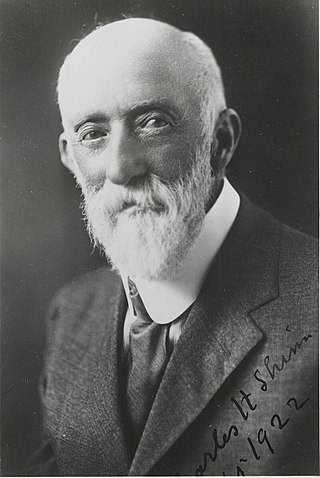
The Federal Depository Library Program (FDLP) is a government program created to make U.S. federal government publications available to the public at no cost. As of April 2021, there are 1,114 depository libraries in the United States and its territories. A "government publication" is defined in the U.S. Code as "informational matter which is published as an individual document at Government expense, or as required by law".

The Los Angeles Chinese massacre of 1871 was a racial massacre targeting Chinese immigrants in Los Angeles, California, United States that occurred on October 24, 1871. Approximately 500 white and Latino Americans attacked, harassed, robbed, and murdered the ethnic Chinese residents in what is today referred to as the old Chinatown neighborhood. The massacre took place on Calle de los Negros, also referred to as "Negro Alley". The mob gathered after hearing that a policeman and a rancher had been killed as a result of a conflict between rival tongs, the Nin Yung, and Hong Chow. As news of their death spread across the city, fueling rumors that the Chinese community "were killing whites wholesale", more men gathered around the boundaries of Negro Alley.

The Alaska State Library and Historical Collections and Talking Book Center are located on the second floor of the Andrew P. Kashevaroff Building in Juneau, Alaska.
The State Library of Oregon in Salem, is the library for the U.S. state of Oregon. The mission of the State Library of Oregon is to provide leadership and resources to continue growing vibrant library services for Oregonians with print disabilities, the Legislature and state government, and all Oregonians through local libraries.

The New York State Library is a research library in Albany, New York, United States. It was established in 1818 to serve the state government of New York and is part of the New York State Education Department. The library is one of the largest in the world by number of items held, with over 20 million cataloged items in 2011.

The 1st Regiment California Volunteer Infantry was an infantry regiment in the Union Army during the American Civil War. It spent its entire term of service in the western United States.

The State Library of North Carolina is an institution which serves North Carolina libraries, state government employees, genealogists, and the citizens of North Carolina. The library is the main depository for North Carolina state publications and serves the needs of North Carolina government agencies and state government employees by providing access to information resources that are vital to public decision-making and economic development.

The Connecticut State Library is the state library for the U.S. state of Connecticut and is also an executive branch agency of the state. It is located in Hartford, Connecticut directly across the street from the Connecticut State Capitol. The State Library provides a variety of library, information, archival, public records, museum, and administrative services to the citizens of Connecticut, as well as the employees and officials of all three branches of state government. Students, researchers, public libraries and town governments throughout the state are also served by the State Library. In addition, the State Library directs a program of statewide library development and administers the Library Services Technology Act state grant. "The mission of the Connecticut State Library is to preserve and make accessible Connecticut's history and heritage and to advance the development of library services statewide."

Charles Downing, was an American pomologist, horticulturist, and author.

The Nebraska Library Commission is a Nebraska state government agency. Located in Lincoln, the Library Commission provides reference, resources, training, and consulting for all types of library in the state. The various collections housed at the Library Commission are used to serve librarians, state employees, seekers of government information, and visually handicapped Nebraskans. The Library Commission is a clearinghouse for state government publications and makes many documents accessible online.

The State Library of Ohio is a state agency that provides services to state government and all types of libraries to ensure that all Ohio residents, rich or poor, rural or urban, receive the best possible library service and are able to engage in lifelong learning which strengthens the economic health of Ohio.
The Western Pacific Railroad (1862–1870) was formed in 1862 to build a railroad from Sacramento, California, to the San Francisco Bay, the westernmost portion of the First transcontinental railroad. After the completion of the railroad from Sacramento to Alameda Terminal on September 6, 1869, and then the Oakland Pier on November 8, 1869, which was the Pacific coast terminus of the transcontinental railroad, the Western Pacific Railroad was absorbed in 1870 into the Central Pacific Railroad.
George Fall was an American politician. He was a member of the Los Angeles, California, Common Council, the governing body of that city, in 1870–71 and was present when a mob lynched 18 Chinese in the Chinese massacre of 1871.
Albert Etter (1872–1950) was an American plant breeder best known for his work on strawberry and apple varieties.

The California Nursery Company was established in Niles, California, and incorporated in 1884 by John Rock, R. D. Fox, and others. The nursery sold fruit trees, nut trees, ornamental shrubs and trees, and roses. It was responsible for introducing new hybrids created by such important West Coast breeders as Luther Burbank and Albert Etter.

Charles Howard Shinn (1852–1924) was a horticulturalist, author, inspector of California Experiment Stations, and forest ranger in California.

John Rock was a German-born American horticulturalist and nurseryman. John Rock was a leader in California in pomology and the nursery business from 1865 until his death in 1904. Charles Howard Shinn wrote the entry for John Rock in L.H. Bailey's Cyclopedia of Horticulture He said "John Rock's scientific spirit, his wide and ever-increasing knowledge, his very high standards of business and his unselfishness made him during his long life the leader of Pacific coast nurserymen. He introduced more valuable plants and varieties to American horticulture than any other man of his period. His connection with Japan, India, Australia and with the great establishments abroad was close and constant. He did much to encourage men like Luther Burbank, and his collections were always at the service of students and the public."
The Kingsburg Recorder is a weekly paper covering Kingsburg, CA and the surrounding communities of Fresno County, California. The paper is owned by Lee Central California Newspapers which, in 2015, combined the Kingburg Reporter with the Selma Enterprise, consolidating printing operations at the Santa Maria Times printing location.

The Sutro Library is a branch of the California State Library located in San Francisco on the campus of San Francisco State University. The foundation of the library's collection was assembled by former San Francisco mayor, engineer, entrepreneur, and philanthropist Adolph Sutro. The library was deeded to the State of California by Sutro's heirs with the stipulation that it never leave the city limits of San Francisco, filling his desire to provide the city with a public research library. It was formally given to California State Library in 1913, and opened to the public in 1917. Notably, half of the Sutro collection survived the "Great Fire" after the San Francisco earthquake of 1906. Collection highlights include 125,000 rare books, antiquarian maps, and archival collections, as well as a genealogical library.

The Tajo Building was a six-story office building on the northwest corner of First and Broadway in downtown Los Angeles, California, in the United States. The building was developed by Simona Martinez Bradbury and named for the Bradbury family's Tajo silver mine in Mexico. The Tajo Building was occupied at various times by the USC Law School, the Los Angeles Stock Exchange and, for the first decade of the 1900s, the United States District Court for the Southern District of California.


















